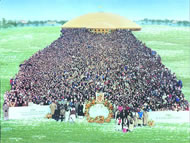SUMMARY
What are the other benefits?
 |
|
 |
|
The first large gathering of
peace-creating experts:
December 1983 |
|
|
Stress in the collective consciousness
not only fuels terrorism and war. It also breeds crime, economic
instability, and governmental incoherence. By reducing social
stress, large groups of peace-creating experts have been shown to
profoundly benefit society in each of these areas.
Reduced
crime: The relationship between peace-creating groups and
reduced crime has been verified repeatedly. The first published
study covered 24 U.S. cities, and was eventually expanded to include
160 cities and 80 Standard Statistical Metropolitan Areas, comprising
almost half the U.S. urban population. Significant demonstrations
have also been held in capital cities around the world— including
Washington, DC, Manila, and New Delhi. DETAILS >
Improved
economic performance: Economic growth depends on the “investor
climate,” “consumer confidence,” and other aspects
of a nation’s collective consciousness. Many studies have
shown that large groups of peace-creating experts, by reducing stress
in the collective consciousness, improve economic performance. For
example, a powerful seven-year study showed that increased attendance
at a peace-creating group was associated with sharp reductions in
the Misery Index (the combination of inflation and unemployment).
DETAILS >
Enhanced
governmental performance: In the Vedic explanations, if a
nation’s collective consciousness becomes more harmonious
and coherent, then the government will mirror that harmony and coherence
in its decisions and actions. For example, an eight-year study
based on data gathered independently by the Zurich Peace Project
showed that higher attendance at a large peace-creating group
was associated with more positive and harmonious actions by the
governments of the United States and the Soviet Union. DETAILS >
|
To move to the next Summary,
click here:

To continue with more detail on this topic,
click here:

|
|


